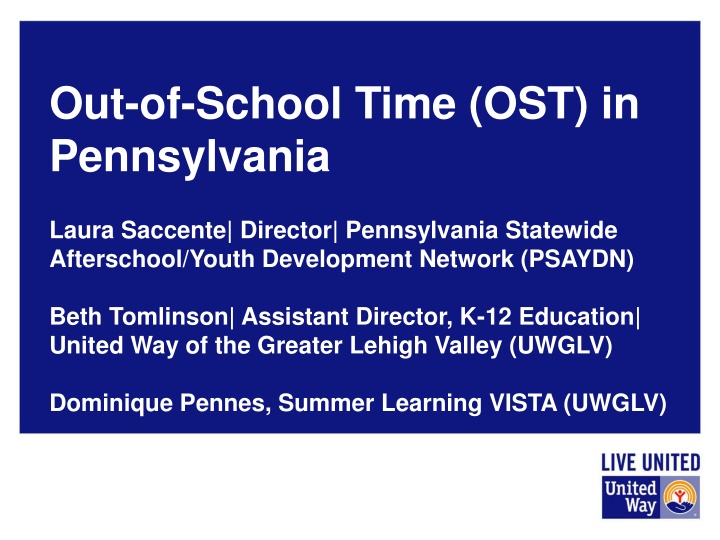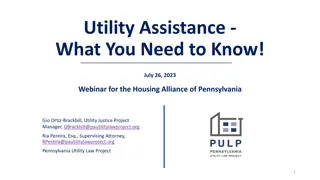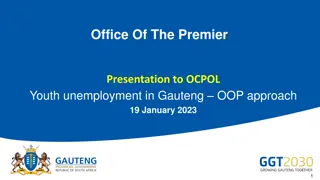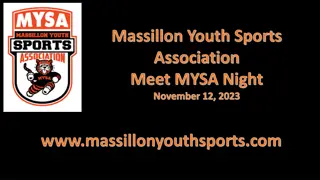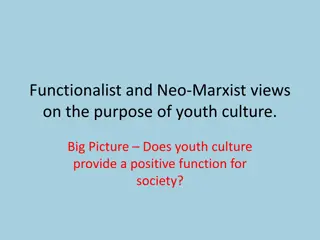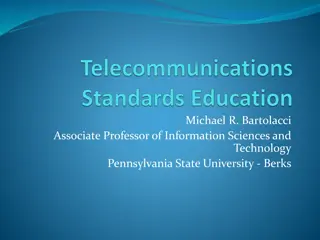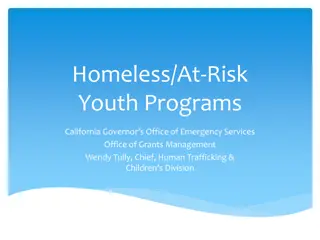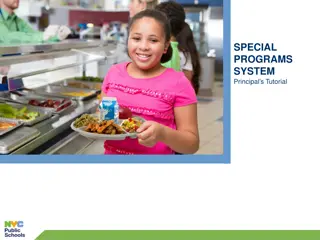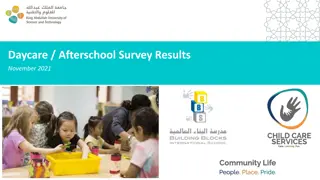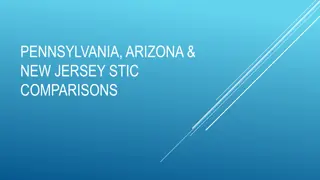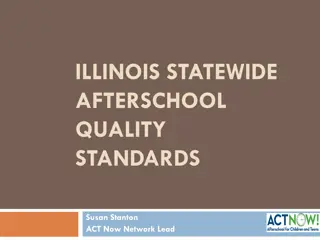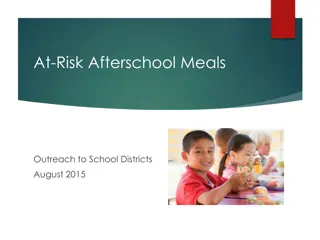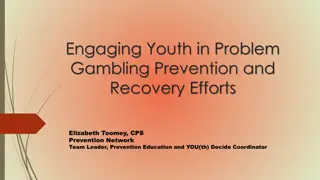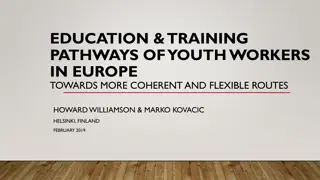Pennsylvania Statewide Afterschool Network and Youth Development Programs
Pennsylvania Statewide Afterschool/Youth Development Network (PSAYDN) promotes sustainable and high-quality out-of-school-time youth development programs in Pennsylvania. Their goals include creating partnerships, supporting policy development, securing resources for afterschool programs, and ensuring program quality statewide. PSAYDN offers various benefits to its members and provides valuable resources for afterschool and summer learning activities.
Download Presentation

Please find below an Image/Link to download the presentation.
The content on the website is provided AS IS for your information and personal use only. It may not be sold, licensed, or shared on other websites without obtaining consent from the author.If you encounter any issues during the download, it is possible that the publisher has removed the file from their server.
You are allowed to download the files provided on this website for personal or commercial use, subject to the condition that they are used lawfully. All files are the property of their respective owners.
The content on the website is provided AS IS for your information and personal use only. It may not be sold, licensed, or shared on other websites without obtaining consent from the author.
E N D
Presentation Transcript
Out-of-School Time (OST) in Pennsylvania Laura Saccente| Director| Pennsylvania Statewide Afterschool/Youth Development Network (PSAYDN) Beth Tomlinson| Assistant Director, K-12 Education| United Way of the Greater Lehigh Valley (UWGLV) Dominique Pennes, Summer Learning VISTA (UWGLV)
Mission PSAYDN promotes sustainable, high- quality out-of-school time youth development programs through advocacy and capacity building to enhance the welfare of Pennsylvania s children, youth and families.
Goals Create a sustainable structure of statewide, regional and local partnerships, particularly school- community partnerships, focused on supporting policy development at all levels. Connecting People Creating Opportunity Support the development and growth of statewide policies that will secure the resources that are needed to sustain new and existing afterschool programs. Changing Lives Support statewide systems to ensure programs are of high quality.
PSAYDN Network Not a PSAYDN member? JOIN today! Go to www.PSAYDN.org @PSAYDN
Member Benefits Member Benefits Weekly e-blast Support in planning and executing quality Lights On Afterschool events Opportunity to network and serve on statewide committees Annual meeting and recognition of OST champions Annual afterschool state advocacy day Afterschool Ambassador Program
Afterschool/Summer Learning Resources Afterschool Alliance www.afterschoolalliance.org National Afterschool Association www.naaweb.org Afterschool STEM Hub www.afterschoolstemhub.org National Summer Learning Association www.summerlearning.org/ National Conference of State Legislatures www.ncsl.org/ 21st Century Learning Centers Pennsylvania www.21stcclc.org/
The Afterschool Field youth development school- linked & school- based school-age child care
Coalition-building OST across the state
Pennsylvania After 3 PM Report 321,296 kids participate in afterschool programs Pennsylvania America After 3PM 2014 Compared to 2009 2009 2014 Kids in Afterschool Programs 15% 17% Kids in Self Care 26% 18% 346,457 kids on their own after school Parents Satisfied with Afterschool Program 84% 93% 811,954 kids would participate Kids Who Would Participate if a Program were Available 32% 50%
Other Areas of Focus for PSAYDN STEM/STEAM COMMUNITY SCHOOLS KEYSTONE STARS REVISIONING SOCIAL EMOTIONAL LEARNING ENVIRONMENTAL EDUCATION SCHOOL IMPROVEMENT LITERACY FAMILY & COMMUNITY ENGAGEMENT CAREER/COLLEGE READINESS
Cutting Edge Research www.stemreadyamerica.org
Quality Matters Research and evaluation point to three primary, interrelated factors that are critical for OST s to create positive Key factors outcomes for children and youth: Access to and sustained participation in the program Quality programming, particularly -Appropriate supervision and structure -A well-prepared staff -Intentional programming Partnerships with families, other community organizations and schools.
Afterschool Matters Children and youth who regularly attend high-quality afterschool programs have: Better grades and conduct in school More academic and enrichment opportunities Better peer relations and emotional adjustment Lower incidences of drug-use, violence and pregnancy
Quality Crosswalk Assessment of Program Practices Tool (APT-O & -Q) School Age Care Environment Rating Scale (SACERS) Youth Program Quality Assessment (Youth PQA Forms A & B) Allegheny Partners for Out-of-School Time Quality Self- Assessment (APOST QSA) Chester Core Standards for Older Youth Programming Self- Assessment Tool PSAYDN Quality Self-Assessment Tool Philadelphia Core Standards Assessment Tool UWGPSNJ Older Youth Program Quality Rubric (PQR)
Future Opportunities Every Student Succeeds Act (ESSA)
Afterschool: Reducing Chronic Absenteeism OST staff can work with parents and school staff to: Create a culture of good attendance in the program and in the school Talk with parents and students about the importance of attendance Suggest and support ways to help parents, families, and students help each other Monitor school attendance data for program participants and reach out when students are chronically absent Help schools identify barriers to good attendance and potential solutions
College/Career Readiness Out-of-School Time offers opportunities for all the things employers say new employees need: 21st Century Skills Problem solving through project based learning opportunities Community service Activities that focus on communication skills Activities that develop interpersonal and team building skills Programs that integrate the use of technology
Afterschool Caucus Senator Ryan Aument (R) Senator John Yudichak (D) Representative Bernie O Neill (R) Representative Jake Wheatley (R)
Future Opportunities Legislative Budget and Finance Committee (LBFC) report recommendation (June 2016 report) Identify stable funding sources for afterschool in PA; Develop a protocol to recruit and retain qualified afterschool staff; Establish quality standards for afterschool programs; Promote the use a statewide afterschool program directory; and Forge strong workforce, business and formal education partnerships.
OST Challenges in PA Dedicated funding/state line-item
Out of School Time Programming in Lehigh Valley, PA UWGLV initiated a Campaign for 3rd Grade Reading in 2014 Part of national effort, sponsored by Annie Casey Foundation 3 key pillars: early childhood education, every day attendance, summer learning 2014-2018, 2018-2022 investment plan aligned to increasing 3rd grade reading, 8th grade math proficiency rates UWGLV supports a community school network in 4 highest need school districts (22 schools in total) 3 urban, 1 rural All UWGLV education program investments serve students/families in one of these 22 community schools
How UWGLV Promotes OST Programs During the school year: Goal of OST = increased student engagement in school; improved student attendance Both before and after school time, school-based Must demonstrate how the OST program supports development of the 5 C s of PYD: Competence, confidence, connection, character, caring/ compassion In Summer Months: Goal of OST = reducing summer learning loss, fighting child hunger Both school and community-based Both program investments and systems change work
Why Summer Learning Matters In 2014, we added summer learning programs to our investment plan. Then we asked partner school districts to prioritize all of our education strategies they all ranked summer learning LAST!! Then we showed this video: https://youtu.be/ZolcNG3GVCs
Community Call to Action! In 2014, the Lehigh Valley Summer Learning Coalition was launched. 3 highest need school districts are active members LVSLC Goals: 1. To increase community awareness of summer learning loss and family engagement in summer learning opportunities 2. To increase access to high quality summer learning programs for low income youth 3. To raise quality of existing summer programs
The Lehigh Valley Summer Learning Coalition Provides professional network for summer providers All providers must add 30 minutes of literacy/day Provides training to raise quality Hosts annual community awareness event: Kick Off to Summer Learning Distributes/Analyzes Summer Provider Surveys Measures summer learning opportunity gap Tracks impact of summer programming on summer slide Hosts online summer learning resource: www.lehighvalleycamps.com Generates newsletters, marketing efforts Solicits summer learning scholarship drives ($15,000)
And NOW Our 3 urban partner school districts ranked behavioral health services #1 and out of school time programming #2: Before and after school programs to promote improved student engagement in school and improved school attendance Summer learning to fight summer slide and summer hunger and help increase grade level proficiency rates Bethlehem Area School District invested significant Title 1 funds to launch a district-wide summer learning program for k-2nd graders across all Title 1 elementary schools
Local Research Efforts: Summer Provider Landscape Launched Summer Provider Survey (2014) Most summer providers rely on family fees to operate, few have the resources to scholarship youth Only 1 in 3 low income youth in Allentown, Bethlehem and Easton were being engaged in summer learning programs - most without needed dosage to fight the summer slide Few community-based providers incorporated literacy Providers said they could double # of low income kids served with if they were provided the resources to add extra staff Used this data to generate interest in local foundations and corporate partners: leveraged $300-400,000 in new dollars Increased # low income youth in SL programs by 6%, higher rate at elementary school level Asked all providers to add 30 min. reading/literacy to program day
Local Research Efforts: What Families Tell Us Launched Parent/Family Survey (2016) Over 1,700 surveys returned, all elementary schools, 3 urban school districts Parents want summer learning opportunities for their kids But they need help with cost, transportation and meals They want math and reading supports BUT they also want the programs to be FUN Math/Reading were top parent picks; arts/sports/STEM second top picks If teachers talk to parents/caregivers about summer learning programs, families are more likely to sign their kids up
Summeralso a time of hunger LVSLC is partnering with LV Food Policy Council to fight child hunger in the summer Added questions on summer meals to summer provider survey Found that 20% of youth eligible for free school meals in LV are being fed over the summer by our summer partners, national average is 15% Developing family messaging on summer meal locations, working with 211 and area school districts to get the word out Geo-mapping need and resources to target interventions and identify likely partners in the solution
What Does The Research Tell Us Summer learning loss disproportionately affects low income youth Summer learning loss is cumulative and damaging over time High quality summer learning programs can prevent summer loss and create summer gains 25 hours of math + 34 hours of reading+ enrichment activities for 20 days or 120 hours = Right Dosage QUALITY MATTERS: to see positive attendance and retention, and achieve positive academic growth LVSLC piloting SL-PQA tool in 10 sites this summer to increase quality programming
Contact Info Beth Tomlinson, betht@unitedwayglv.org Dominique Pennes, dominiquep@unitedwayglv.org
